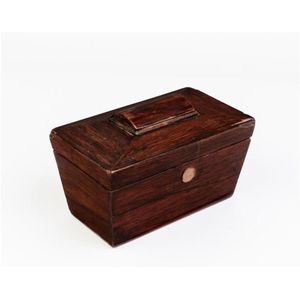English Tea Caddy Trio - 19th Century
You must be a subscriber, and be logged in to view price and dealer details.
Subscribe Now to view actual auction price for this item
When you subscribe, you have the option of setting the currency in which to display prices to $Au, $US, $NZ or Stg.
- Mahogany - Mahogany is a dense, close grained red-coloured timber from the West Indies and Central America. It was first imported into Europe in the the early 18th century and its use continued through the 19th century. It was popular for furniture making because of its strength, the wide boards available, the distinctive grain on some boards, termed flame mahogany and the rich warm colour of the timber when it was polished.. The "flame" was produced where a limb grew out from the trunk of the tree, and this timber was usually sliced into veneers for feature panels on doors, backs and cornices.
Some terms used to describe mahogany relate to the country from which it originally came, such as "Cuban" mahogany, "Honduras" mahogany etc. However unless the wood has been tested the names assigned are more a selling feature, rather than a true indication of the timber's origin. - Rosewood - A dense timber that varies in shade to very light brown to almost black. When rosewood is cut and sanded the colour of the timber will turn black, and after polishing and exposure to daylight, the surface will gradually lighten over time to light brown with black streaks.
The name comes from the odour emanating from the timber when it is planed, sanded or cut.
Rosewood was very popular for use in Victorian furniture in the second half of the 19th century, and at that time most of the rosewood was imported from Brazil. However it also grows in India and Indonesia.
It is used in the sold for chairs and table legs, but for carcase furniture such as side cabinets and bookcases, and for table tops it is always used as a veneer. - Satinwood - Satinwood is a dense pale gold coloured timber that was imported into Britain in the second half of the 18th century, and early 19th centuries from the East Indies and the West Indies. The name derives from the satin-like surface sheen when the timber is polished.
It was used in the solid, as a veneer and in inlays. As well as furniture, satinwood was used for making musical instruments, barometers, boxes and clocks.
It will usually be found on only the very best quality objects, presumably because of of its cost at the time.
This item has been included into following indexes:
Visually similar items

Pa Kahawai with wooden shank, paua shell inlay & iron hook Y10621. Length 9 cm

A Chinese seated bronze and coloured Buddha, the seated meditative Buddha wearing a Crown and simple stylised and engraved clothing in subtle red, bottle green and gold colours, the left hand in vitarka mudra, the symbol of teaching. Height 25 cm. Width 17

Wembley Ware wall pocket in the form of a yellow crested cockatoo resting on gumtree branch, incised to underside 'Wembley Ware', length 13.5 cm

A sterling silver pocket watch, with key and chain, key wind fusee movement, dial marked 'Greenwich, Timekeeper, Warranted', case hallmarked Chester 1882, with maker?E.L.? likely, Edwin Lee, the movement marked?J. Simmons, Birmingham? with, white enamel di
